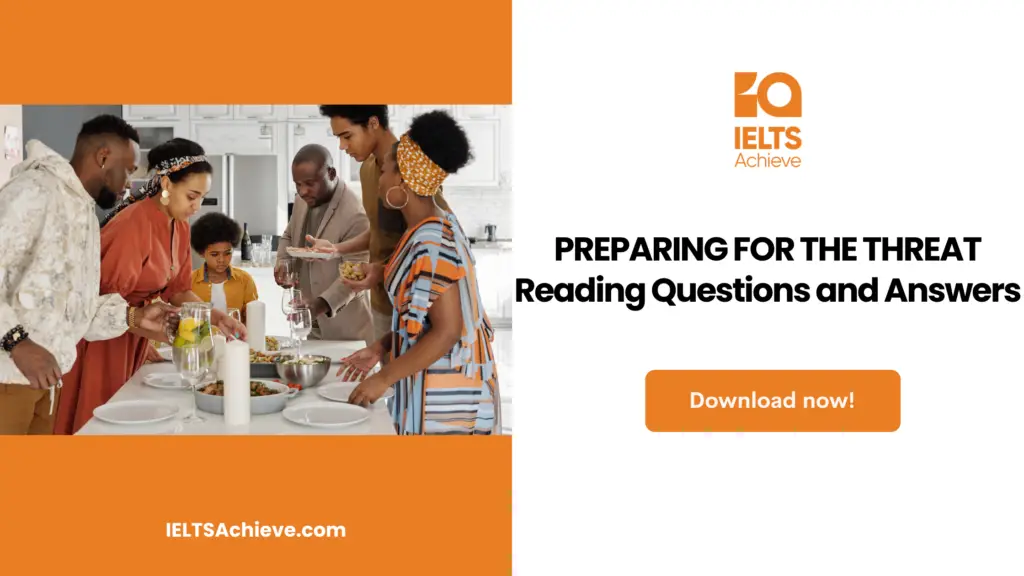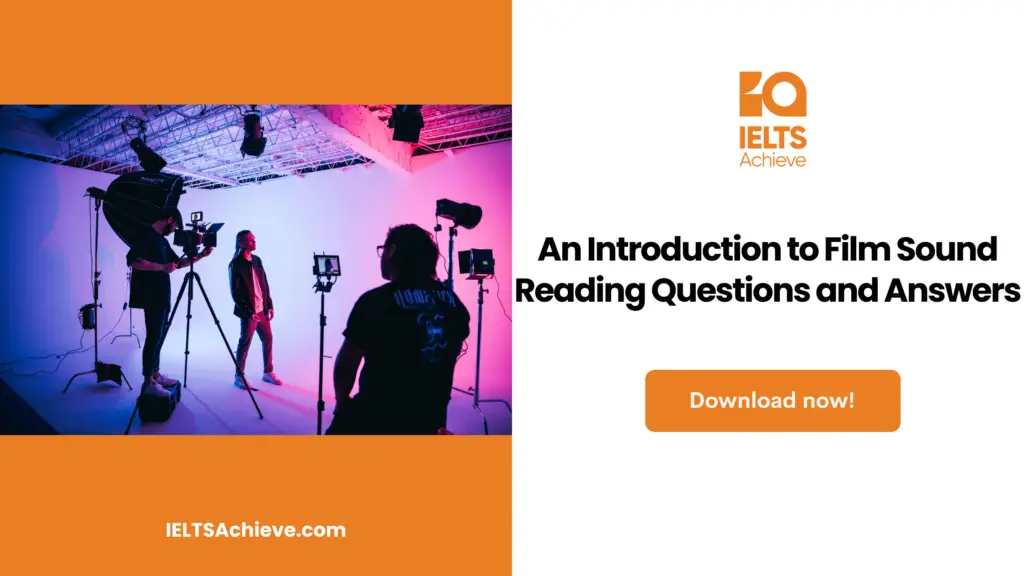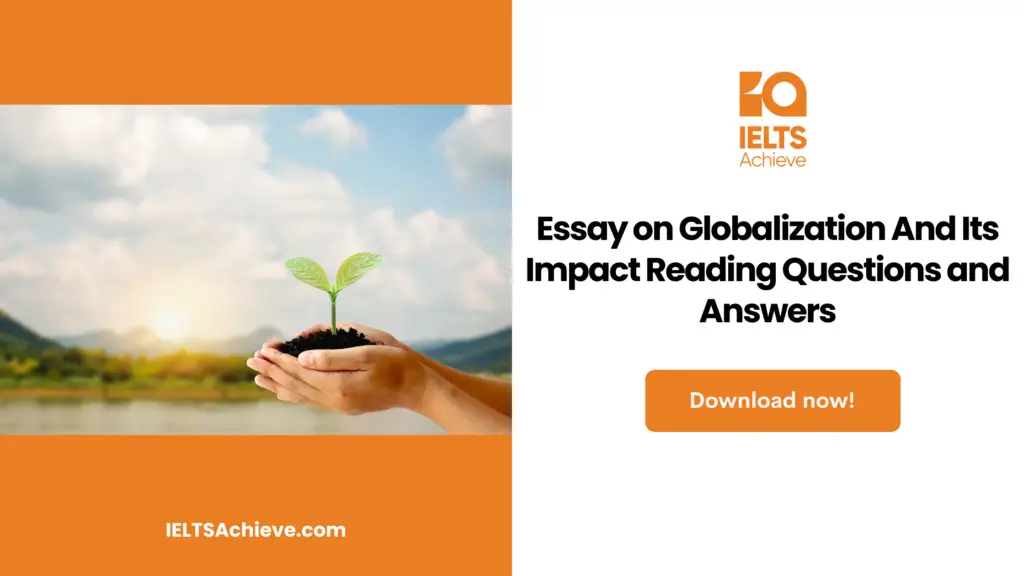The Blog post contains the following IELTS Reading Questions:
- IELTS Reading Matching Features
- IELTS Reading True/False/Not Given
- IELTS Reading Multiple Choice Questions
Stay informed and prepared for success – Explore our comprehensive Reading Test Info page to get valuable insights, exam format details, and expert tips for mastering the IELTS Reading section.
IELTS Reading Passage – PREPARING FOR THE THREAT

PREPARING FOR THE THREAT
It is an unfortunate fact that over the past 20 years, around 260 million people a year have been affected by natural disasters around the world. Regrettably, a vast majority of the victims of this staggering number are from developing countries. Whether it be earthquakes, tornadoes, floods, volcanoes or tsunamis, over the past twenty years, natural disasters have been happening more frequently and affecting more people than ever before. It follows that the international community should address the issue of ‘disaster preparedness’ and establish a process by which natural disasters are dealt with.
On December 26, 2004, a massive earthquake centered off the coast of the Indonesian island of Sumatra caused a series of deadly tsunamis in the Indian Ocean. The damage from this extraordinary disaster was estimated to be in the vicinity of US $ 13 billion – the equivalent to the combined GDP 1 of the world’s developing countries for an entire year. In a matter of seconds, the tsunami waves wiped out the long years of struggle for development, and the world was once again reminded of the fearsome and destructive power of natural disasters.
1 Gross Domestic Product is the total value of goods and services produced by a country in a year.
The United Nations designated the 1990s as the International Decade for Natural Disaster Reduction, and has been active in promoting and developing international cooperation on disaster preparedness. The UN’s Yokohama Strategy for a Safer World: Guidelines for Natural Disaster Prevention, Preparedness and Mitigation was adopted in 1994. Among the guidelines, developing countries are encouraged to organise and implement their domestic resources for disaster reduction activities and donor developed countries are encouraged to give greater priority to disaster prevention, mitigation and preparedness in their assistance programs and budgets, including through increasing financial contributions.
In January, 2005 the UN World Conference on Disaster Reduction (WCDR) met in Kobe, Hyogo Prefecture to discuss and debate how the international community should address issues of disaster preparedness and mitigation. The meeting itself attended by over 4,000 delegates representing some 168 countries occurred almost 10 years to the day after the Great Hanshin earthquake in Kobe. The January meeting of the WCDR in Kobe provided experts and scientists from over 150 countries, government officials, Non- Government Organisation (NGOs) and United Nations representatives an opportunity to review the Yokohama Strategy. It recorded on the 2005-15 Yokohama Strategy Action Plan that participant countries and agencies should work over the next 10 years to reduce vulnerability to natural disasters. The Action Plan encourages as a first step, the integration of disaster prevention programs in all development and policy-making plaits for all countries. Jim Edgeland, UN representative stated, “Disaster risk reduction is not an additional expense – it is an essential investment in our common future, but the benefits of this investment will be calculated not only in dollars or euros or yen saved, but most importantly, in saved lives in every corner of the globe.”
Perhaps the most significant work done at the WCDR meetings was the drafting and adoption of the Hyogo Declaration, This document expresses the united determination of the international community to rely not only on advanced technology or facilities for disaster preparedness, but on a people-centered early warning system. The people-centered system requires effective communication and education in the building of disaster-resilient countries and communities.
As the intergovernmental panels of the WCDR were meeting, the Great Hanshin-Awaji Earthquake Forum was also underway. The earthquake measuring a magnitude of 7.3, led to the Joss of over 6,400 lives and widespread destruction affecting some 460,000 households. This public forum offered a variety of sessions, during which the lessons learned from the disastrous earthquake were discussed. Earthquake expert Professor Tomohiro Kawata said, “Because this disaster happened over a decade ago, the memory of the devastation can be forgotten. Part of our gathering here today is to make sure that we do not forget what happened back in 1995.’’ Also included were some personal stories from the earthquake victims themselves. Earthquake victim Kumiko Nagota told attendees that her house collapsed in the Kobe earthquake and she was trapped under it. She tried to call for help but after a while she lost her voice and just had to wait there until help came. Attendees were told of bow the town mobilised to facilitate recovery and reconstruction. An exhibition hall showed pictures of mounds of rubble produced by the earthquake as well as a display of objects donated by earthquake victims including a broken clock and a child’s toy that molted in the fires caused by the earthquake. Said Kawata, “As well as being a memorial, our facility and, indeed this forum, is a place to learn from earthquake experiences and incorporate the things we learned into our preparations for future disasters”. During the forum, it was agreed that in May 2005, a new hub for the coordination of international disaster recovery support activities wrould be established in Kobe.
Unlock your full potential in the IELTS Reading section – Visit our IELTS Reading Practice Question Answer page now!
Recommended Questions:
Renewable Energy IELTS Reading Question with Answer
Questions 1 – 4
Do the following statements agree with the information given in Reading Passage?
In boxes 1-4 on your answer sheet, write
TRUE if the statement agrees with the information
FALSE if the statement contradicts the information
NOT GIVEN if there is no information on this
1) Mostly people from poorer countries are affected by natural disasters.
2) Present-day natural disasters are more dangerous than disasters of the past.
3) It will take the countries affected by the tsunami many years to rebuild.
4) Being prepared and knowing what to do in a disaster should be a global issue.
Enhance your skills in identifying information as True, False, or Not Given. Click here to discover expert strategies and techniques for mastering this question type in the IELTS Reading section.
Questions 5 – 8
Choose the correct letter, A, B, C or D.
Write the correct letter in boxes 5-8 on your answer sheet
5. According to the passage, reducing the risk of disasters is important because
A. countries can then focus on growth and development.
B. communities will be drawn together in support of each other.
C. help international communities to be more economically stable.
D. it will save lives and money.
6. According to the writer, the most important outcome of the World Conference on Disaster Reduction (WCDR) was the
A. discussion and debate amongst the international community attendees.
B. chance for participants to review the Yokohama Strategy.
C. writing and acceptance of the Hyogo Declaration.
D. acknowledgement that disaster risk reduction is an investment in the future.
7. The town of Kobe was effectively rebuilt due to
A. the support of the United Nations.
B. the people of Kobe.
C. the Government of Japan.
D. the leadership of Professor Kawata.
8. The stated purpose of the Great Hanshin-Awaji Earthquake Forum was
A. to help others Ire better prepared for any future natural disasters.
B. for people to learn more about natural disasters.
C. to remember the Kobe earthquake of 1995.
D. for people to remember and team from what happened.
Ready to improve your performance in Multiple Choice Questions (MCQs)? Click here to access our comprehensive guide on how to tackle MCQs effectively in the IELTS Reading section.
Questions 9 – 13
Look at the following statements (Questions 9 – 13) and the list of disaster control initiatives below.
Match each statement with the correct disaster control initiative, A-D.
Write the correct letter, A-D, in boxes 9-13on your answer sheet.
9) people should be the early broadcasters of disaster information
10) led to a new central area for support in disaster recovery
11) a reminder of the impact of disasters
12) in times of disaster, developed countries should do more to help less-developed countries
13) national development and disaster prevention should be considered at the same time
Disaster Control Initiatives
A. Hyogo Declaration
B. Great Hanshin-Awaji Earthquake Forum
C. World Conference on Disaster Reduction
D. Yokohama Strategy for a Safer World
Improve your performance in Matching Features questions by clicking here to access our comprehensive guide. Learn how to match specific features or characteristics with the options provided in the IELTS Reading section.
Unlock your full potential in the IELTS Reading section – Visit our IELTS Reading Practice Question Answer page now!
Recommended Questions:
Renewable Energy IELTS Reading Question with Answer
Answers
1) T
2) NG
3) NG
4) T
5) D
6) C
7) B
8) D
9) A
10) B
11) B
12) D
13) D

We hope you found this post useful in helping you to study for the IELTS Test. If you have any questions please let us know in the comments below or on the Facebook page.
The best way to keep up to date with posts like this is to like us on Facebook, then follow us on Instagram and Pinterest. If you need help preparing for the IELTS Test, join the IELTS Achieve Academy and see how we can assist you to achieve your desired band score. We offer an essay correction service, mock exams and online courses.

